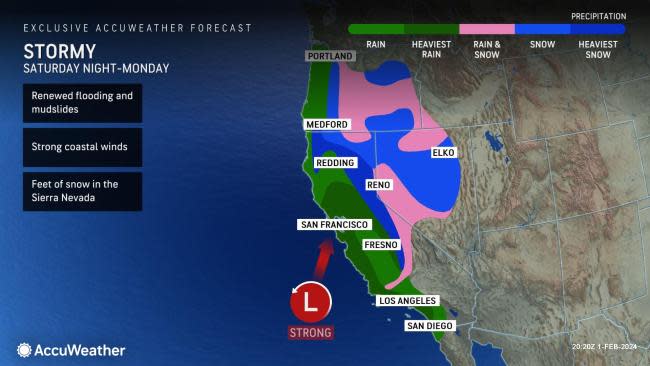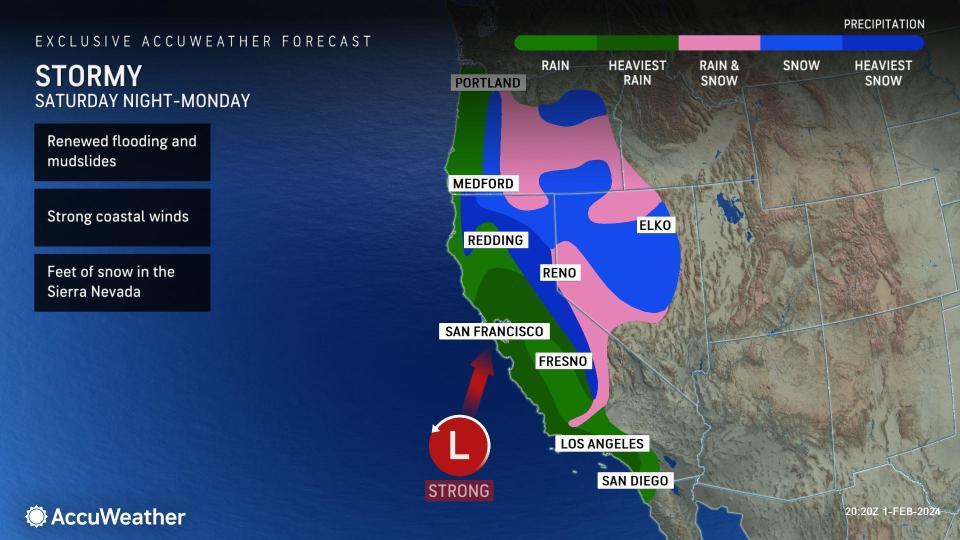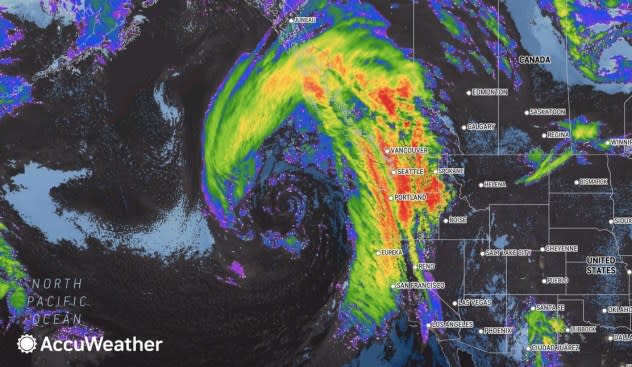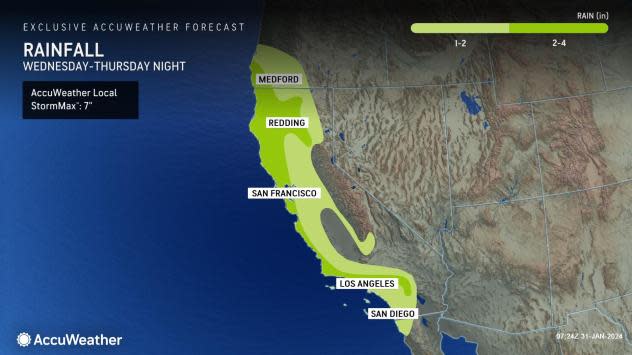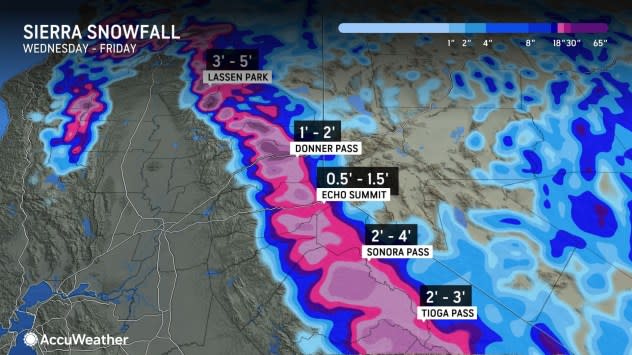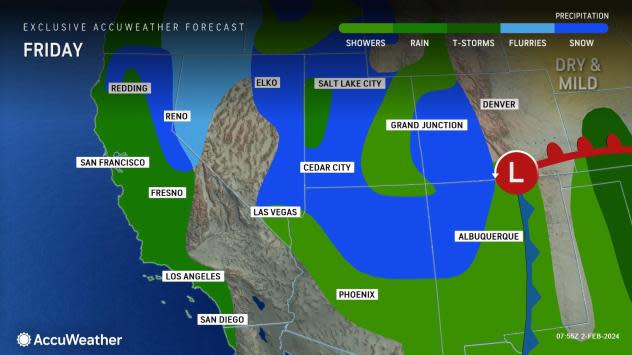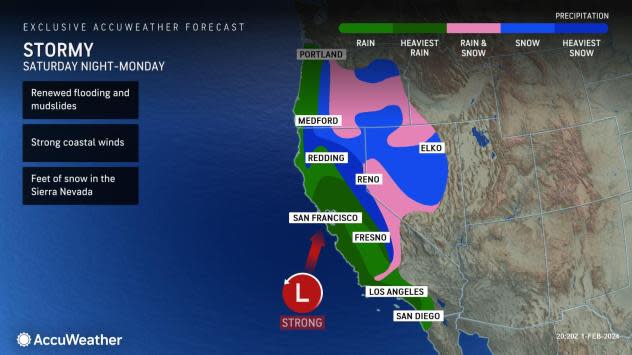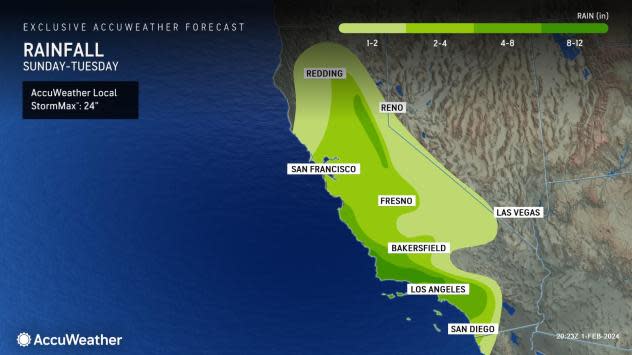Atmospheric rivers to fuel the 2 biggest storms of the winter in California
A meteorological double-whammy will pound the West Coast with heavy rain and mountain snow, starting with one storm that lasted into Thursday night, followed quickly by another storm arriving Sunday. Both will tap into moisture from atmospheric rivers, heightening the flood risk for millions, AccuWeather meteorologists warn.
The proximity of the second storm to the first, hitting roughly the same areas, could escalate flooding, mudslides and power issues. Rounds of large waves from both storms will pummel the California coast into next week. There will be the potential for overwash, coastal erosion and property damage.
The first storm funneled copious amounts of moisture like a giant firehose southward through California through Thursday night before shifting inland over the southwestern United States on Friday and Saturday.
Satellite images on Wednesday morning showed clouds from the first storm spanning nearly 2,000 along the Pacific coast from Los Angeles to Juneau, Alaska.
 |
This image, captured early Wednesday on Jan. 31, 2024, shows a potent storm reaching the Pacific Coast of the United States. (AccuWeather Enhanced RealVue™ Satellite) |
Much of Northern California was on the receiving end of 1-4 inches of rain from the first storm into Thursday morning. Similarly, coastal areas of Southern California can expect 1-4 inches of rain, with several tenths of an inch to 1 inch falling over the interior deserts into Thursday night. In both Northern and Southern California, locally higher first storm total amounts of 4-6 inches are likely along the west- and southwest-facing Coast Ranges with an AccuWeather Local StormMax of 7 inches.
 |
The rain from the first storm will continue to be heavy enough to lead to incidents of flash urban flooding as it swings across the interior Southwest.
The steadiest rain from the first storm has come to an end across much of California, with the worst of the rain and flash flooding potential pivoting toward Palm Springs, California, Las Vegas and Yuma, Arizona, as of early Friday morning.
As the first storm swung southward, snow levels lowered from north to south across the southern Cascades and Sierra Nevada. Motorists can still encounter difficult travel over Donner Pass, California, as snow continues through Friday morning before tapering to snow showers Friday afternoon.
A general 1-2 feet of snow will fall on the intermediate elevations and most passes of the Sierra Nevada, with 2-4 feet likely at some of the resorts and most ridges and peaks into Friday.
 |
"By the time it gets cold enough for snow over the passes in Southern California into Friday morning, much of the storm's moisture will be fleeting," AccuWeather Senior Meteorologist John Feerick said.
As drier air causes rain and mountain snow to diminish and become more showery through Friday over much of California, areas of rain and mountain snow will spread from Arizona to Montana from Friday to the weekend.
 |
Motorists may encounter slushy and slippery conditions along stretches of Interstate 15 in Utah and Idaho, with conditions ranging from wet and slushy to snow-packed along Interstates 25, 70 and 80.
Snow around the Denver metro area from Friday night through Saturday will range from a slushy coating around the airport to the east to a general 6-12 inches over the Rockies to the west, where an AccuWeather Local StormMax™ of 30 inches is most likely to occur. Motorists should anticipate slow travel, while airline delays are likely due to deicing operations.
 |
The same storm will transfer much of its energy and moisture toward the Gulf Coast region this weekend with areas of flooding rain and severe thunderstorms.
Hot on the heels of the first storm, a second and more potent storm will roll in from the Pacific during the latter part of the weekend into early next week.
"The second storm originated from near Hawaii and is likely to have a true plume of tropical moisture associated with it," AccuWeather Senior Meteorologist Day Pydynowski said.
This Pineapple Express may focus its heaviest rain from San Diego and Los Angeles to near San Francisco, where several inches to more than a foot of rain may fall over a couple of days. The highest amounts of rain are likely over the west- and southwest-facing slopes of the Coast Ranges of Southern California. However, drenching rain will still fall on much of Southern and Northern California and southern Oregon away from of the mountains.
 |
Even heavier snow will fall on the Sierra Nevada when compared to the last storm, as the plume of moisture may linger longer than the first. This means that some major roads may close for a time and secondary roads could become blocked with snow for days.
Because of the second storm's rapid-fire nature-- coming only a couple of days after the first storm soaked and blanketed the state-- travel and flooding problems from the second storm may be more extensive and much worse than those from the first storm. Expect major urban and small stream flash flooding as well as significant rises on some of the larger rivers in the region with flooding in unprotected areas.
The second storm and its slower-moving atmospheric river may unload two times the amount of rain or more on Central and Southern California compared to the first storm.
 |
The second storm may cause major trouble for travelers heading home from weekend ventures and for businesses and schools at the start of the new week. Torrential rain may pour down so fast and furious that it leads to widespread flash flooding, rapid debris flows, and a high risk of mudslides on the saturated ground.
The combination of snow from both storms spanning the middle of this week to early next week may deliver 5-10 feet of fresh snow on the high country of the Sierra Nevada. The anticipated snowfall should put the Sierra snowpack back on track and then some for the winter.
 |
Rainfall from the two storms will push totals since the start of the rainy season in early October to well above the historical average in many cases. Downtown Los Angeles could come close to doubling its pre-storm total of 5.23 inches from Tuesday in less than a week. Rainfall in San Francisco could surpass 15 inches from Oct. 1.
Want next-level safety, ad-free? Unlock advanced, hyperlocal severe weather alerts when you subscribe to Premium+ on the AccuWeather app. AccuWeather Alerts™ are prompted by our expert meteorologists who monitor and analyze dangerous weather risks 24/7 to keep you and your family safer.

 Yahoo News
Yahoo News 